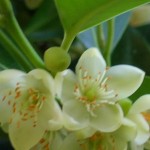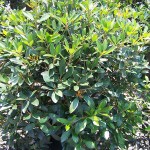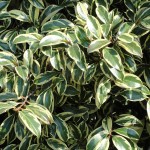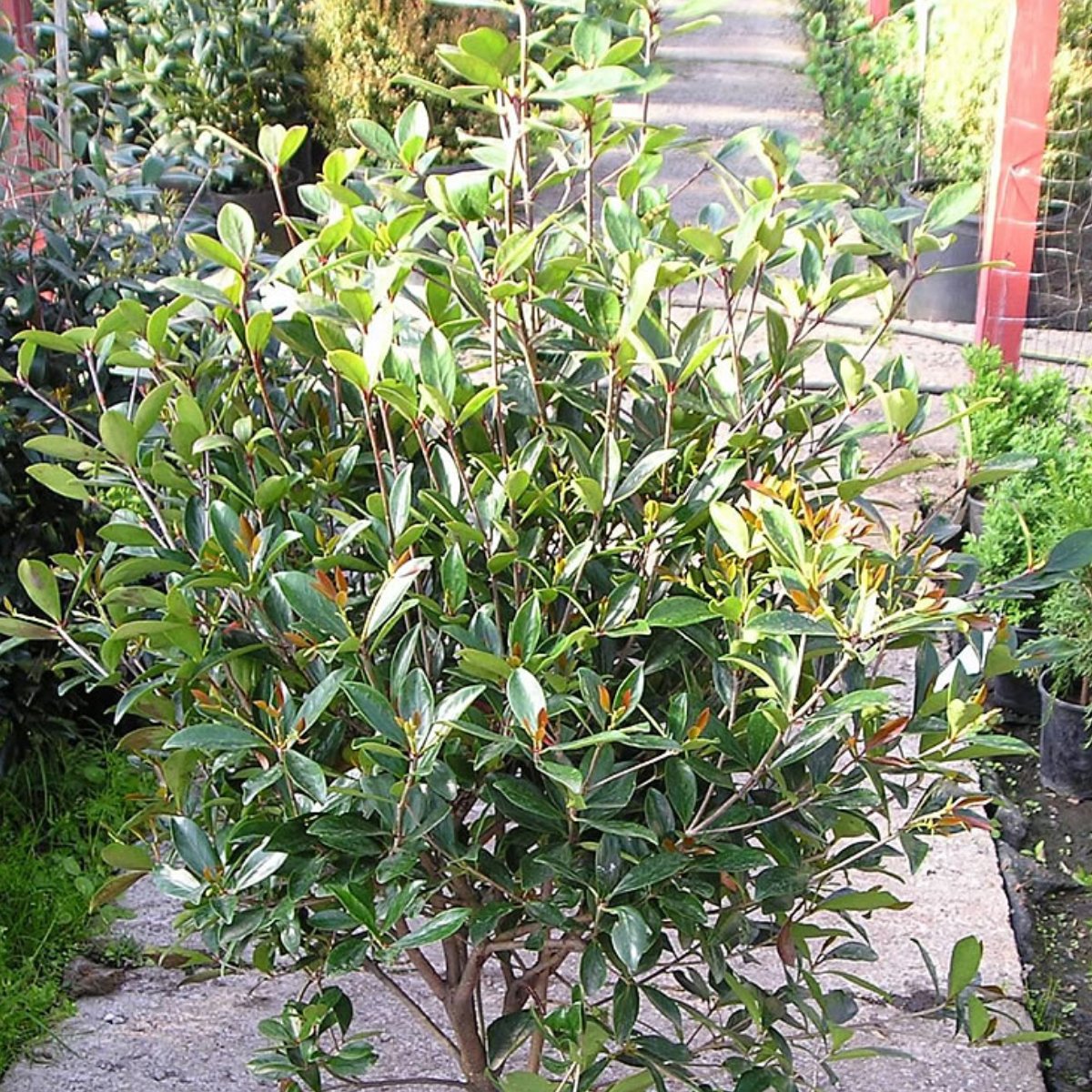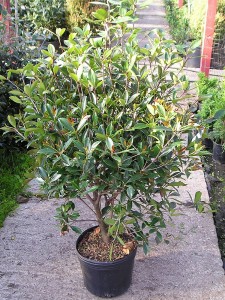Family: Pentaphylacaceae
Synonymous: Cleyera fortunei
Distribution and habitat: Cleyera japonica is a flowering evergreen tree native to warm areas of Japan, Korea, and mainland China. It can reach a height of 10m (33 feet) and is one of the common trees in the second layer of the evergreen oak forests.
Cleyera japonica is considered a sacred tree in the Shinto religion.
Description: Cleyera japonica is a branching shrub with glossy, elliptic, bunt-tipped leaves which are 7-10cm (3-4 inch) long and around 7cm (3 inch) wide. The leaves are dark green above, yellowish-green below. Young leaves and those grown in very bright light may have a rosy tinge, particularly near the edges. The short stalked leaves are arranged in tow ranks on the branches, one on either side.
When it is cultivated outdoor, it forms a dense, compact, rounded shape when young, but matures into an upright multi-trunked large tree up to 10m (33 feet) with handsome dark reddish brown and smooth bark. The small, scented, cream-white flowers appear on the previous year's wood in late spring and early summer. The five-petaled, nodding blooms give rise to attractive small, fleshy, inedible fruits that are yellow-green maturing to bright red or black. These showy cherry-like fruits ripen in fall and persist through winter.
Houseplant care: Cleyera japonica is slow growing and it can be kept compact by occasionally removing the shoot tips. When pruning to control the size or shape of this plant, cuts should be made just above a leaf bud and at a slight angle. This bud will be where the new growth sprouts.
Plants that are cultivated in pots indoors seldom grow more that 60-75cm (24-30 inch) high. They sometime produce small, white scented flowers.
Light: Grow Cleyera japonica in bright light. They will benefit from some direct sunlight every day, but it is not essential.
Temperature: These plants do well in normal room temperatures during the active growth period. During the winter rest period, however, they should ideally be kept quite cool 10-13C (50-55F).
Watering: Cleyera japonica have dense root structure consisting of many finely branched roots that dry out rapidly. During the active growth period water moderately, as much as necessary to make the potting mixture thoroughly moist and allow the top centimetre (0.4 inch) or so of the potting mixture to dry out between waterings. During the rest period let the top third of the potting mixture dry out between moderate waterings.
Feeding: Apply a liquid fertiliser regularly (about every two weeks) during the active growth period.
Potting and repotting: Use a soil based potting mixture. Move plants in pots one size larger as soon as new growth begins each year. After they have reached maximum convenient pot size, an annual topdressing with fresh mixture at this time will suffice.
Gardening: Cleyera japonica grows at a moderate rate with graceful, spreading, arching branches. These moderately drought-tolerant plants are also low-maintenance and maintain their attractive foliage during the cold months, adding winter interest to the landscape.
Pruning may be needed to remove dead branches, encourage bushier growth, promote more flowers or maintain a specific size or shape. Best time for pruning is in spring. Dead branches should be removed close to the trunk, flush with the bark. When prune for neatness, cut back any growth that is especially vigorous and out of place. Instead of cutting the tips of the stems out (which will result in two new stems growing at the outside of the tree), cut the stem back to the center of the plants. This technique will keep the inside or center of the plant full and eliminate excessive growth on the outside controlling the wideness of Cleyera japonica.
When Cleyera japonica is planted in group to form hedges, a regular shear may needed to keep them shaped. They can tolerate relatively hard pruning as hedge.
Position: Cleyera japonica excels in partial shade in a location that will allow its roots to spread and branches to grow freely.It will tolerate full sun, but especially the variegated form will appreciate some protection from afternoon sun.
Space this plants far enough from building foundations, walls and decks so that the growing foliage wold not crowd the structure.
Soil: Cleyera japonica thrives in sandy, fertile, acid soil, although it will tolerate slightly alkaline soils and some clay.
Prepare the planting area by digging a hole as deep as the root ball and three times as wide. After removing the soil, mix it with some compost or peat moss. This enriches the soil and loosens the existing dirt so that new roots can spread easily. Remove the plant from the container by gently brace the base of the plant, tip it sideways and tap the outside of the pot to loosen. Rotate the container and continue to tap, loosening the soil until the plant pulls smoothly from the pot. The container can also be removed by carefully cutting it down the side. Set the plant in the middle of the hole. Start filling the hole with soil and firmly pack it around the root ball. Fill the hole until the soil line is just at the base of the plant, where the roots begin to flare out from the main stem.
Add a layer of mulch, such as shredded bark, about 5cm (2inch) tick around the planting area to preserve the humidity into soil and keep away weeds from the plant. Keep the mulch at least 10cm (4 inch) away from the trunk of the plant as this can keep the bark too moist and cause it to decay.
Irrigation: New planted Cleyera japonica need regular watering through the first growing season. During hot spells thoroughly soak the ground around the plant every few days. Deep watering encourages roots to grow further into the ground resulting in a sturdier plant with more drought tolerance. Water regularly when the top 5 to 10cm (2-4 inch) of soil is dry to touch. Monitor the new plants through the first two years to make sure they are getting the moisture they need. After that they should be sturdy enough to survive on their own.
Fertiliser: Established trees should be fertilized every 2-3 years. Feed in early spring when plants start growing. Use a slow release fertiliser designed for trees ans shrubs. Follow the fertiliser package directions for application rates and scheduling. Over-fertilising can hurt these plants.
Propagation: Take tip cuttings 7-10cm (3-4 inch) long in late winter or early spring. Strip away the lower leaves, dip the cut ends in hormone rooting powder and plant them in a moistened mixture of equal parts peat moss and sand or a substance such as perlite.
Keep the cuttings in a warm place in bright filtered light (a translucent blind or curtain is a useful filter) and water them moderately, enough to make the potting mixture moist. After the roots have formed, probably in six to eight weeks, move the young plants into small pots of soil-based potting mixture and from then on treat them as mature Cleyera japonica.
Problem:
In hot rooms mist spray Cleyera japonica with water daily to discourage red sprier mites which thrives in very warm, dry conditions. It will also help to stand the plants on trays of damp pebbles.
Treatment: If the mites should become really troublesome (as indicated by leaves becoming yellowish with white webbing on the underside), spray the plants with an appropriate insecticide.
Recommended varieties:
Cleyera japonica 'Tricolor' is an attractive variegated leaved variety. The leaves are marbled in pale and dark green and edged with yellow. This variety rarely produce flowers.
Note: Cleyera japonica is often confused with Eurya Japonica, which is actually a closely related and very similar plant.
Uses and display: Cleyera japonica is commonly planted in gardens, parks and shrines. It is often associated with Japanese gardens. This is an exceptionally plant that looks great either pruned or left to its own devices. It is ideal for screening, large hedges or foundations and is pretty enough to plant as a specimen. It also works well as an outdoor or indoor container plant. It suits tropical, oriental, formal and cottage designs.
It is best used as a single specimen to provide some weight to the landscape or as a hedge. Many shrubs can be regularly sheared to keep them shaped as a formal or informal hedge, edging or formal foundation planting. They make beautiful evergreen hedge or screen. Red-tinted foliage adds a touch of color to mixed shrub borders.
SUMMARY:
CHARACTERISTICS:
Foliage green
Shape bushy
Height indoor: 60-75cm (24-30 inch)
Height outdoor: 10m (33 feet)
PROPER CARE:
Watering in rest period moderately
Watering in active growth period moderately
Light bight
Temperature in rest period min 10C max 13C (50-55F)
Temperature in active growth period min 16C max 24C (61-75F)
Humidity high
Hardiness zone: 7a-10b
